Why Another State-of-the-Art Survey Report? Even For Search?
We could have written a fluffy report about "digital transformation" and "workplace efficiency."
Instead, we surveyed 100+ knowledge workers across industries to uncover a single truth:
How much time do teams actually waste searching for information they know exists somewhere?
When 73% of companies don't even know enterprise search solutions exist.
And they’re burning thousands in adding even more SaaS tools every year.
Someone needed to crunch the numbers for the C-suite executives. And that’s yours truly.
We surveyed people, and even conducted interviews to find what the modern Search experience looks like.
While you can find the full report here, this is a roundup of 10 of the most interesting findings we uncovered. So, let’s go.
Who We Surveyed
We asked over 100 people how they search for work information. Here's who they are.
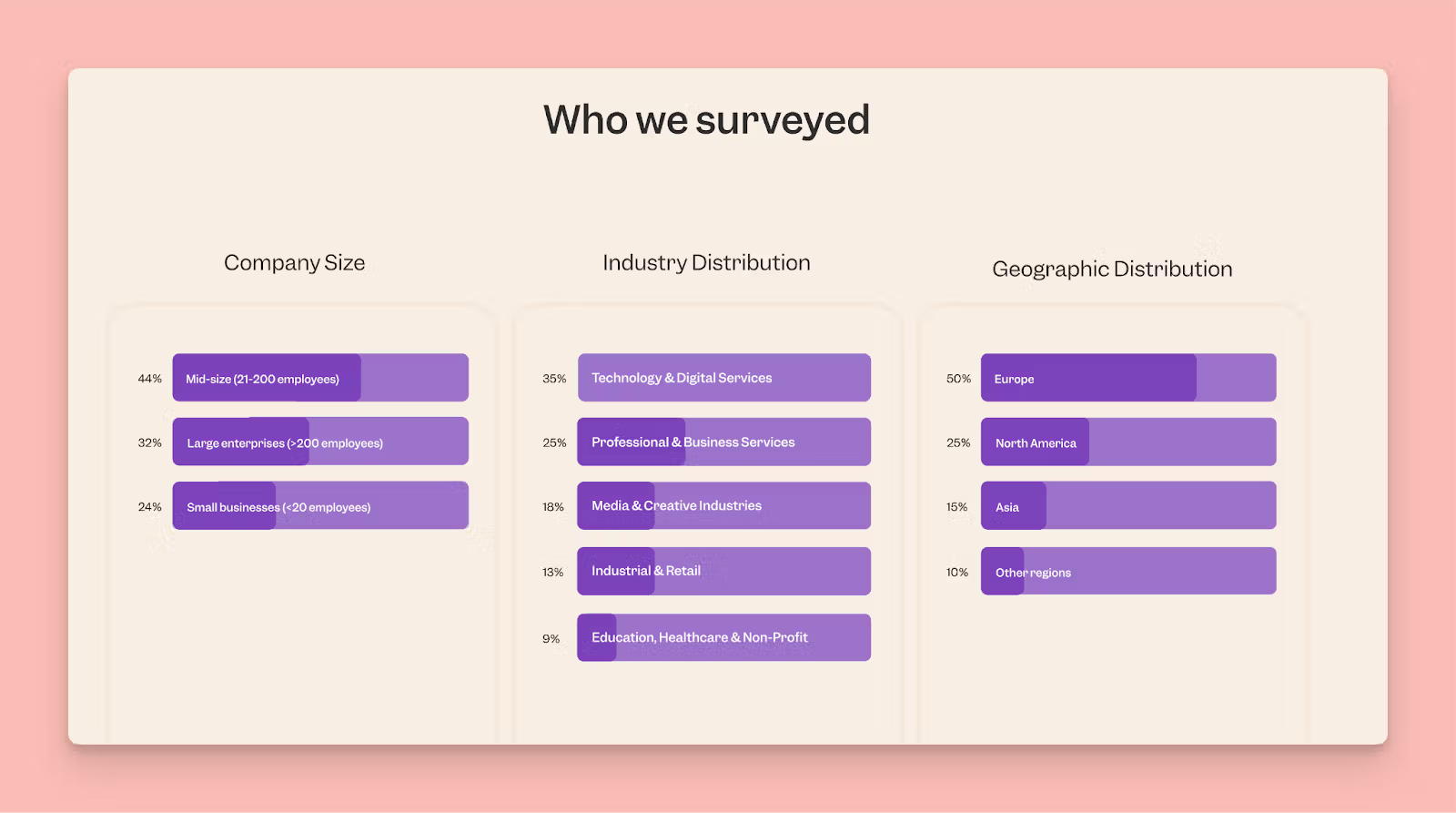
Most responses came from mid-sized companies - the ones with 21-200 employees. They made up 44% of our survey. Large companies with over 200 people represented 32%, while smaller teams under 20 people covered 24%. Search habits change as teams grow, so we wanted to hear from companies at every stage.
The industry mix tells an interesting story. Tech and digital services teams led with 35% of responses, followed by professional services at 25%. Media and creative teams came in at 18%, industrial and retail at 13%, and education/healthcare wrapped up the list at 9%. Each sector searches differently, uses different tools, and needs different information.
Half our respondents work in Europe, a quarter in North America, 15% in Asia, and 10% elsewhere. Time zones matter when you're looking for answers - what's a quick question at 9am in London is a midnight message in Singapore.
Finding #1: Quick questions are never quick
Here's a workplace paradox: there's no such thing as a quick question anymore. What the data reveals is fascinating - we've created a system where getting answers has two price tags: the time spent searching and the time spent waiting.
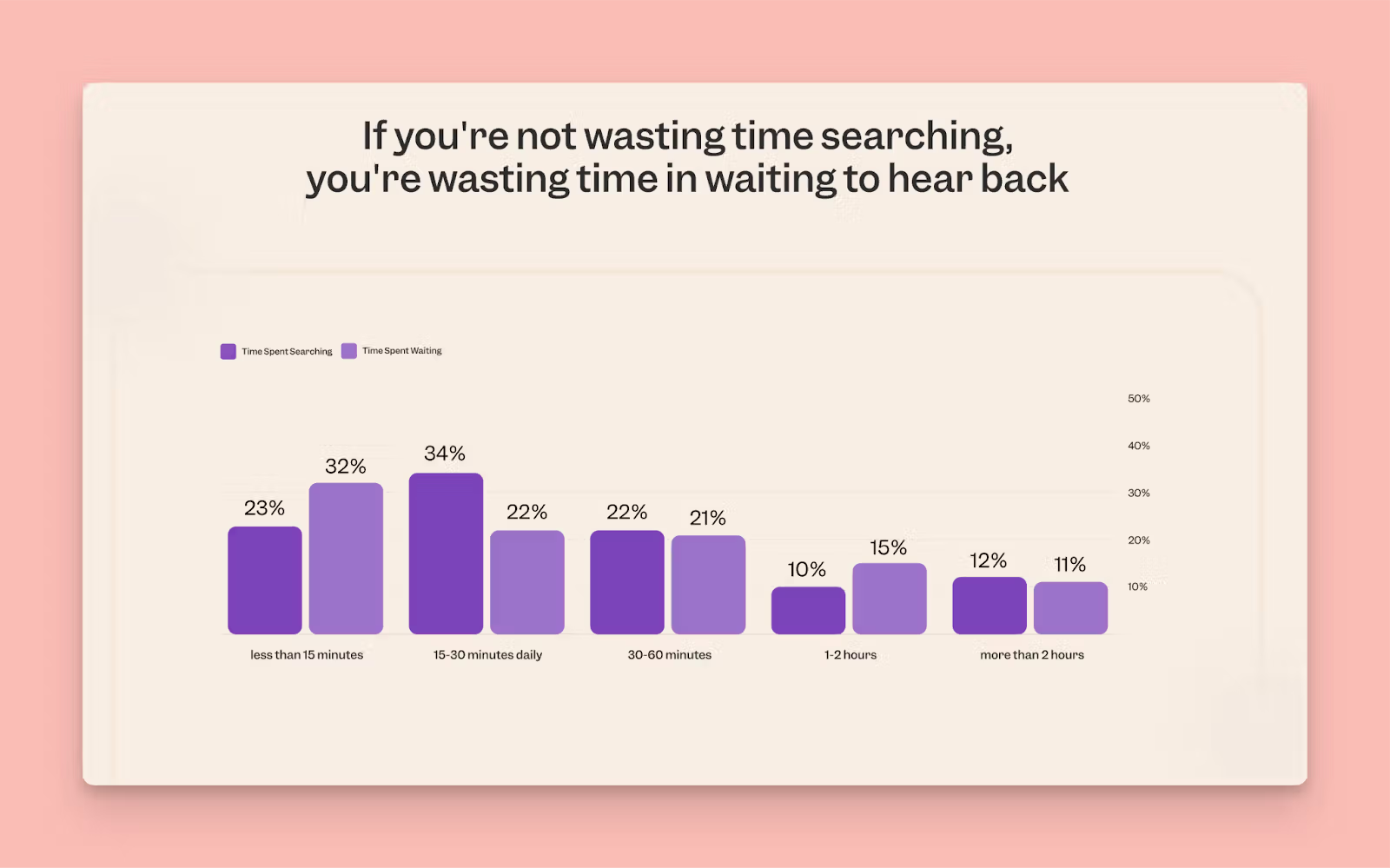
What's particularly striking is how this creates an invisible tax on productivity. Think about it: when 34% of workers spend 30-60 minutes daily just waiting for responses, we're paying twice for every piece of information. The searcher stops working to look, and the answerer stops working to help.
Global teams have it even worse. When a developer in Tokyo needs an answer from the product team in Toronto, that "quick question" can turn into a 12-hour delay. We've normalized this waiting game so much that teams don't even count it as a problem anymore - they just build delay buffers into their projects.
The real insight? In trying to be helpful and answer these questions, we've actually created a more expensive problem than the one we're trying to solve.
Finding #2: The Tool Stack Is Getting Dense
Each department brings its own favorites: Sales lives in their CRM, Engineering camps in GitHub, Design keeps everything in Figma.

And there’s no all-in-one tool that fits every company. You’re bound to get better SaaS tools and implement them in your workflow. And that’s perfectly fine. The problem is navigation.
They remember seeing that strategy doc in Notion. Or was it Google Docs? Maybe someone dropped it in Slack?
Finding #3: Search Success Rate Is Alarmingly Low
Very few people find what they need on their first search attempt.
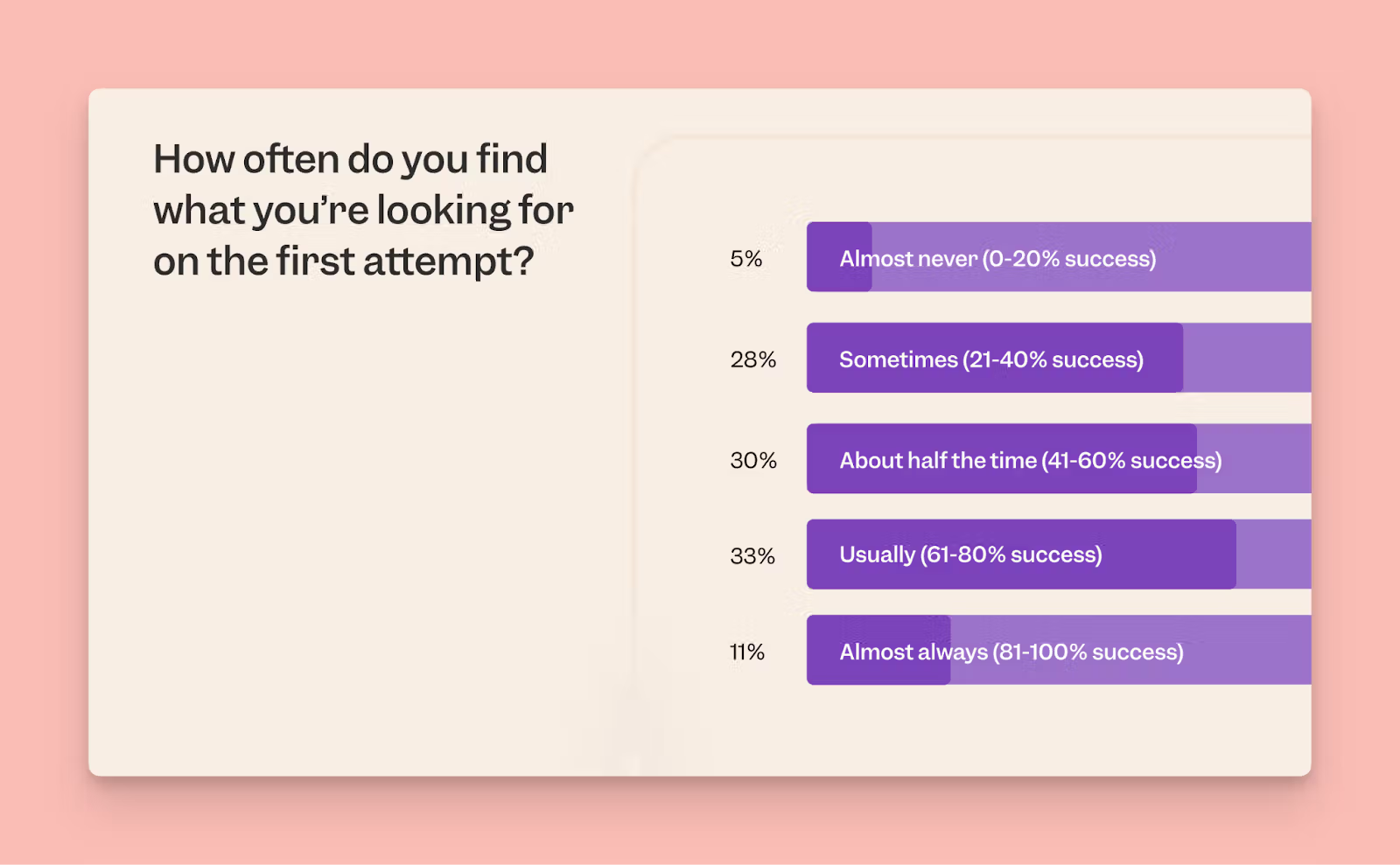
The success rate breakdown reveals:
- Almost always (81-100% success): 11%
- Usually (61-80% success): 33%
- About half the time (41-60% success): 30%
- Sometimes (21-40% success): 28%
- Almost never (0-20% success): 5%
The gap between consumer and enterprise search is stark - while Google achieves 95% first-page accuracy, internal enterprise searches have only a 10% first-attempt success rate, creating a 9.5x performance gap. Users bounce between tools, documents, and chat threads, causing ripple effects across projects and deadlines.
Finding #4: Six Universal Search Challenges Persist
Knowledge workers face consistent obstacles regardless of company size or industry. The primary challenges are:
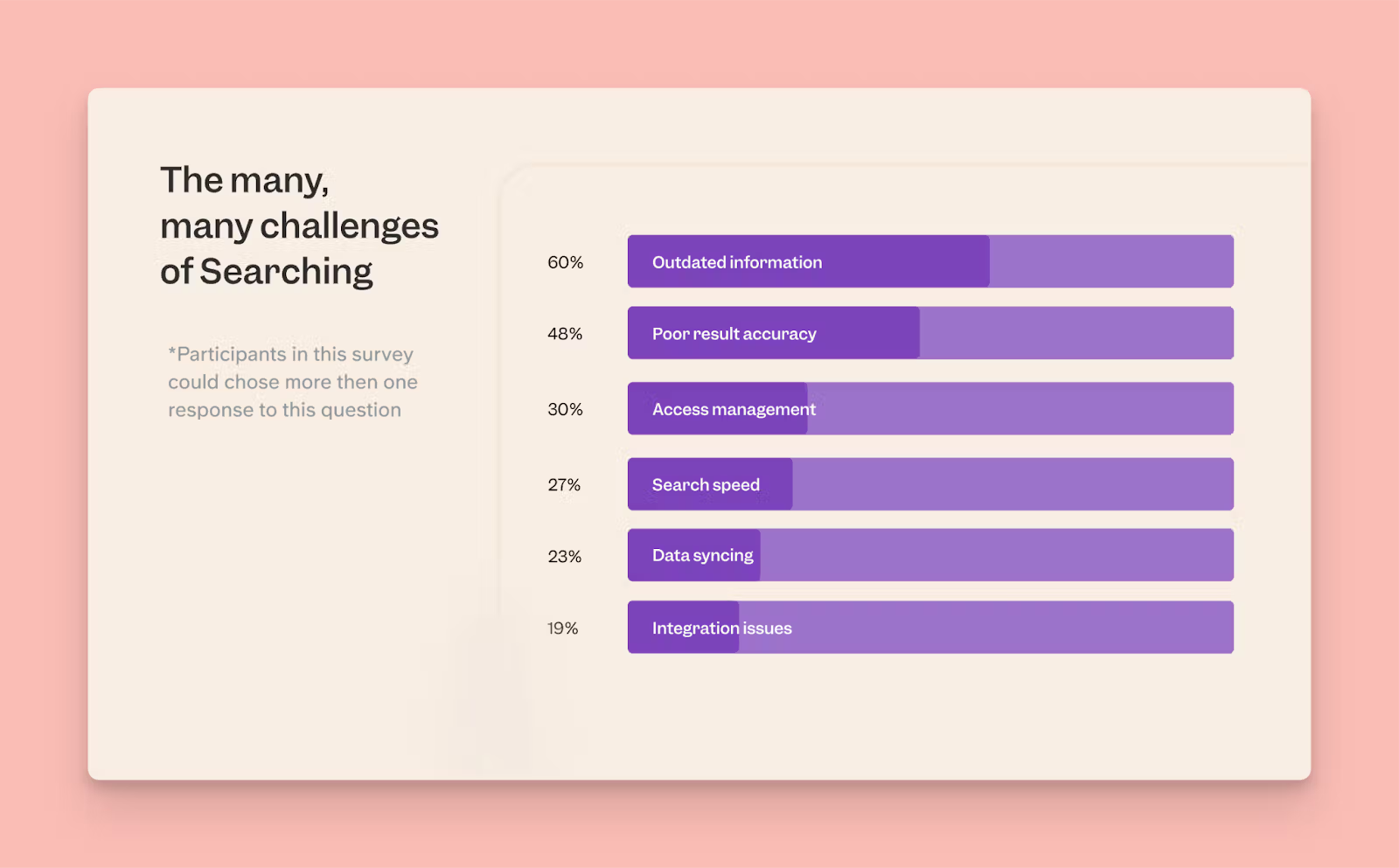
A critical missing element is the Knowledge Manager role. While companies assign owners for sales, events, and other functions, search experience often lacks dedicated oversight. This gap becomes particularly significant when facing multiple challenges that require more than just technological solutions. Knowledge Managers serve three vital functions:
- Control: They curate and validate information flow, transforming scattered data into reliable knowledge assets.
- Context: As information architects, they help teams understand how different pieces of knowledge interconnect.
- Chemistry: They create bridges between information silos by establishing shared vocabularies and consistent access methods.
Finding #5: Poor Search Creates Business-Wide Impact
The business costs of inadequate search extend far beyond mere inconvenience:
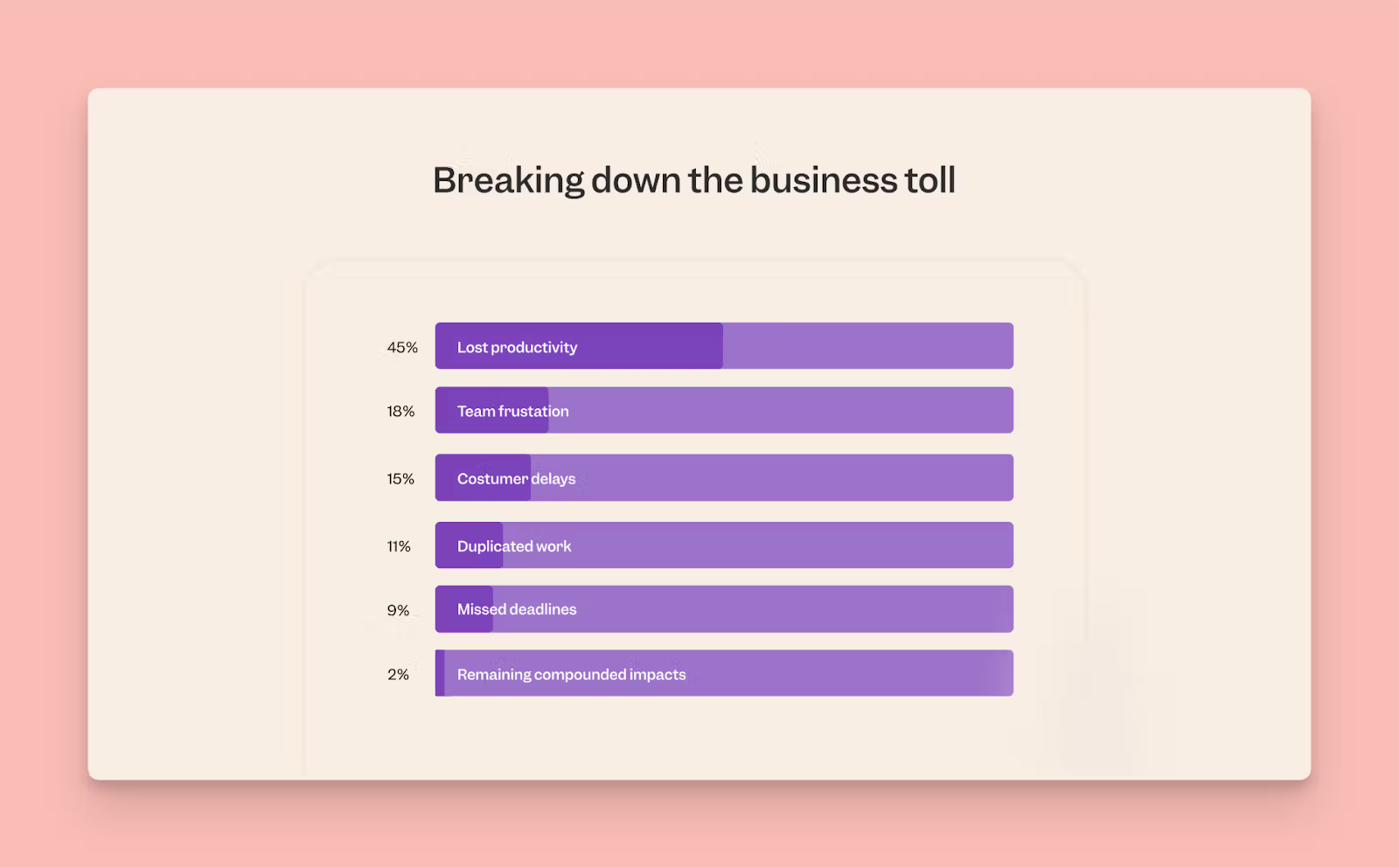
The impact is twofold - first in the search itself, then in recovery time.
With 45% productivity drain and 18% frustration, 63% of search problems directly affect workforce potential. The revenue impact cuts deeper: customer delays (15%) and missed deadlines (9%) mean nearly a quarter of search failures affect external relationships.
Combined with 11% spent on duplicate work, organizations are effectively paying employees to recreate solutions that already exist.
What appears as a mere tooling issue reveals itself as a business emergency, affecting both internal operations and customer relationships.
Finding #6: Security remains a big question
While teams are eager for better search solutions, security concerns remain the primary blocker. The report breaks down the key barriers:
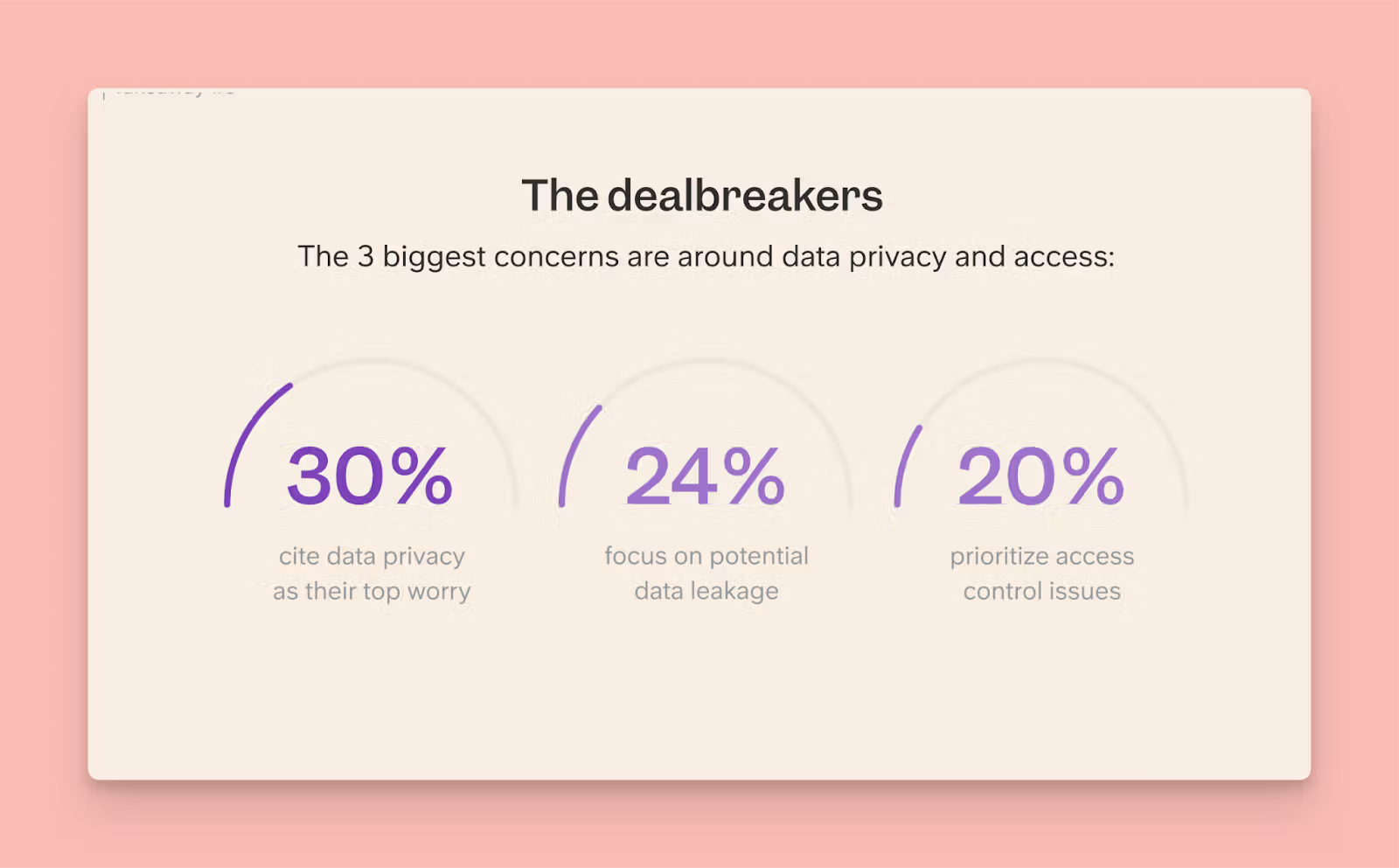
Secondary Concerns:
- 12.7% - Compliance requirements
- 10% - Third-party integration risks
Teams want unified search across every data source - from cloud storage to local drives to third-party tools. But they need ironclad privacy controls, role-based access limits, and audit trails. The market is clear: security must come first, not last.
Finding #7: Knowledge workers have 5 issues with Search
Teams aren't just passively complaining - they have a precise vision for what effective workplace search should look like.
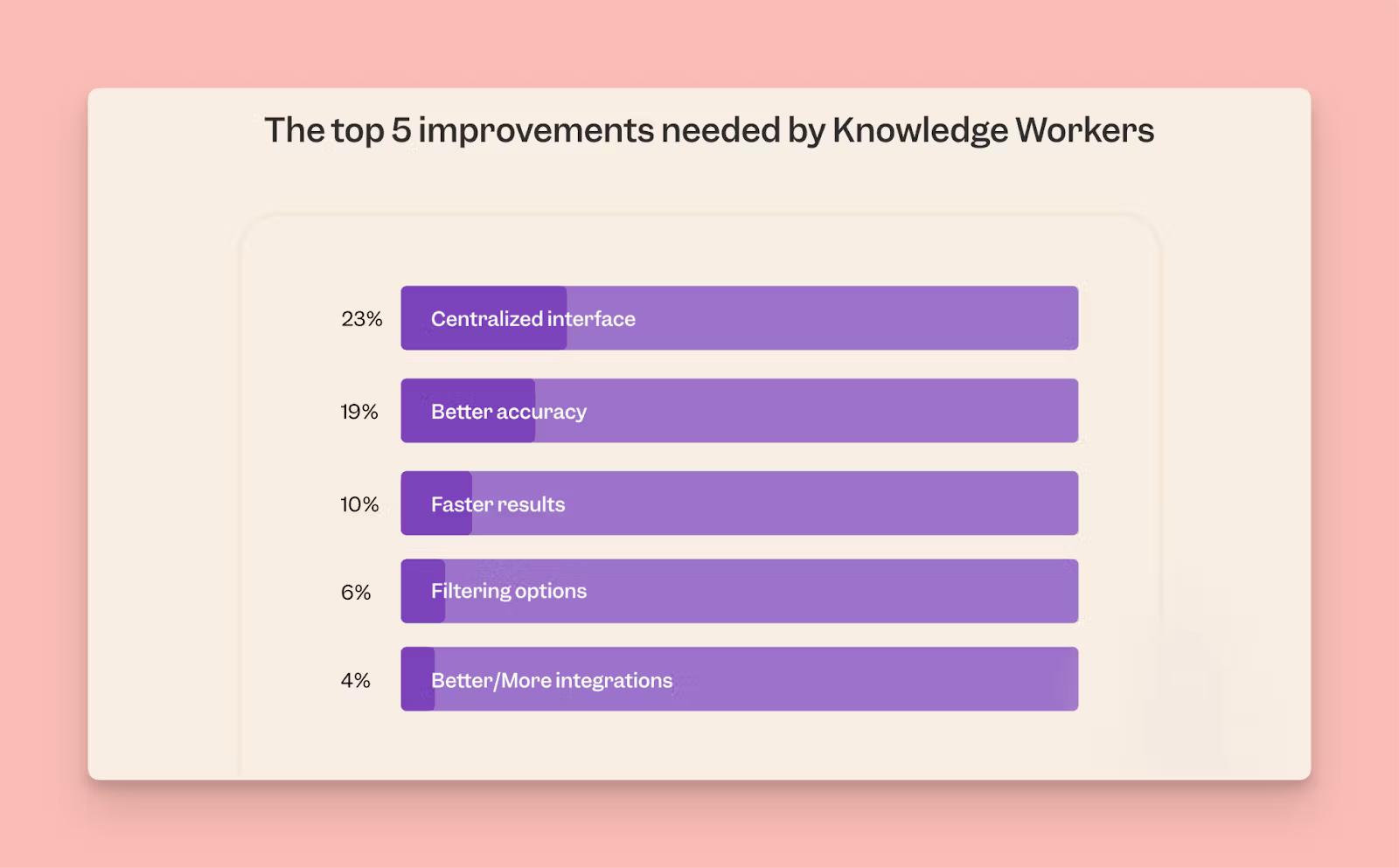
The priority list is topped by the need for a centralized interface, reflecting the frustration with constantly switching between platforms. Search accuracy follows as the second most crucial improvement, highlighting that finding information isn't just about having a single search box - it's about getting relevant results.
Speed emerges as the third priority, with workers expecting consumer-grade search performance in their enterprise tools. The demand for better filtering options and improved integrations rounds out the wishlist, showing that teams need both precision and breadth in their search capabilities.
The current satisfaction levels paint a stark picture of the status quo, with nearly three-quarters of workers expressing dissatisfaction with their search setup. This dissatisfaction is compounded by tool fragmentation - the daily juggle between multiple platforms that forces workers to remember not just what they're looking for, but where they might have stored it.
As specialized tools continue to proliferate, this fragmentation challenge will only intensify.
Finding #8: People even know what they want from Enterprise Search
The ones who are using Enterprise Search aren’t perfectly happy either. There’s a few improvements they need ASAP:
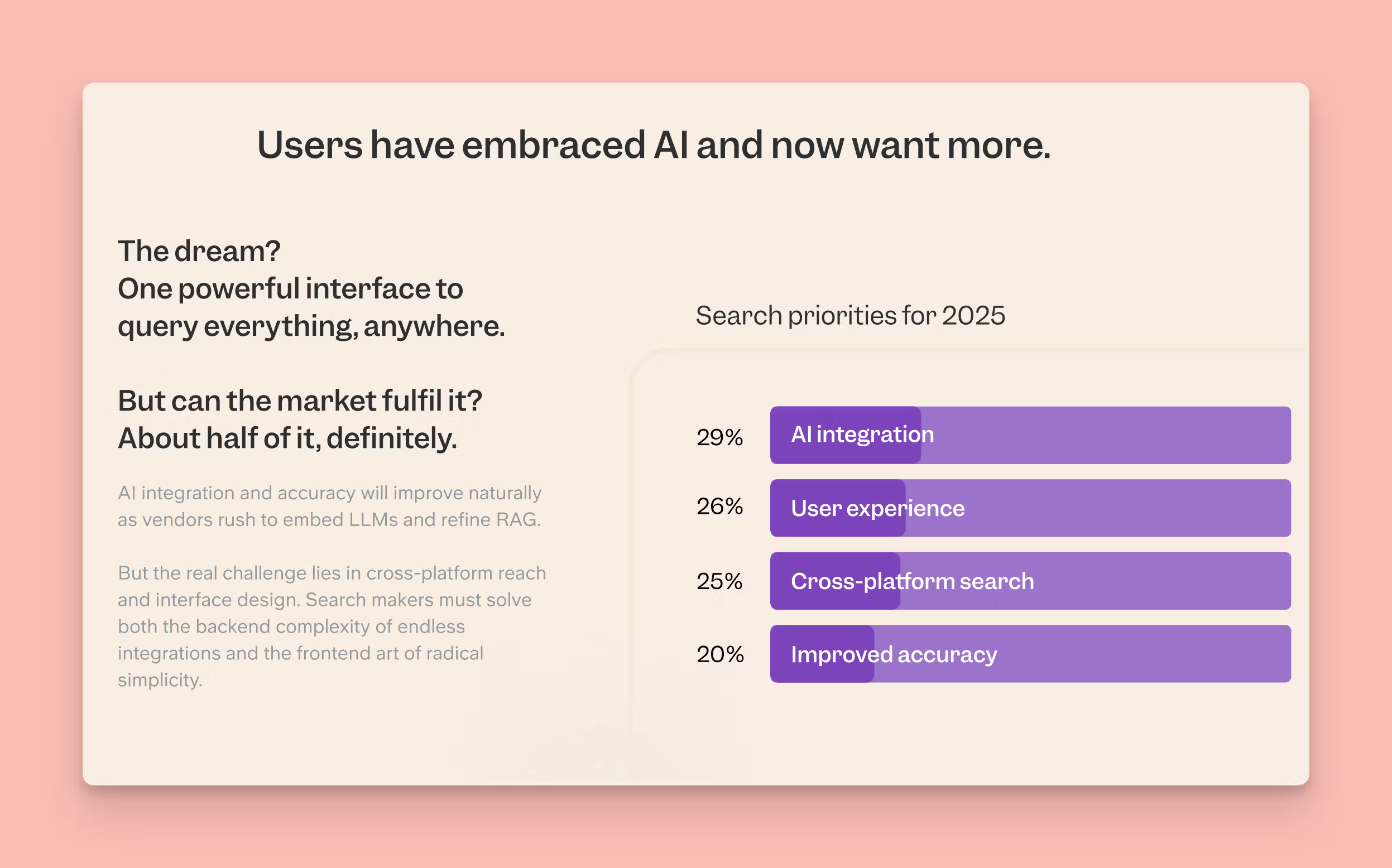
AI is fundamentally transforming workplace search expectations. Knowledge workers expect intelligent assistance in processing and utilizing information. The shift is from passive search to active intelligence, where systems don't just retrieve but interpret and suggest.
This evolution brings both opportunity and urgency. On one hand, AI promises to bridge the longstanding gap between consumer and enterprise search experiences. Intelligent systems can understand context, recognize patterns, and deliver increasingly relevant results. They can surface not just exact matches, but conceptually related content that humans might miss.
Finding #9: Enterprise Search Adoption Is At A Tipping Point
The above finding comes from the few who do know of Enterprise Search tools.
73% of organizations don't have an enterprise search tool.
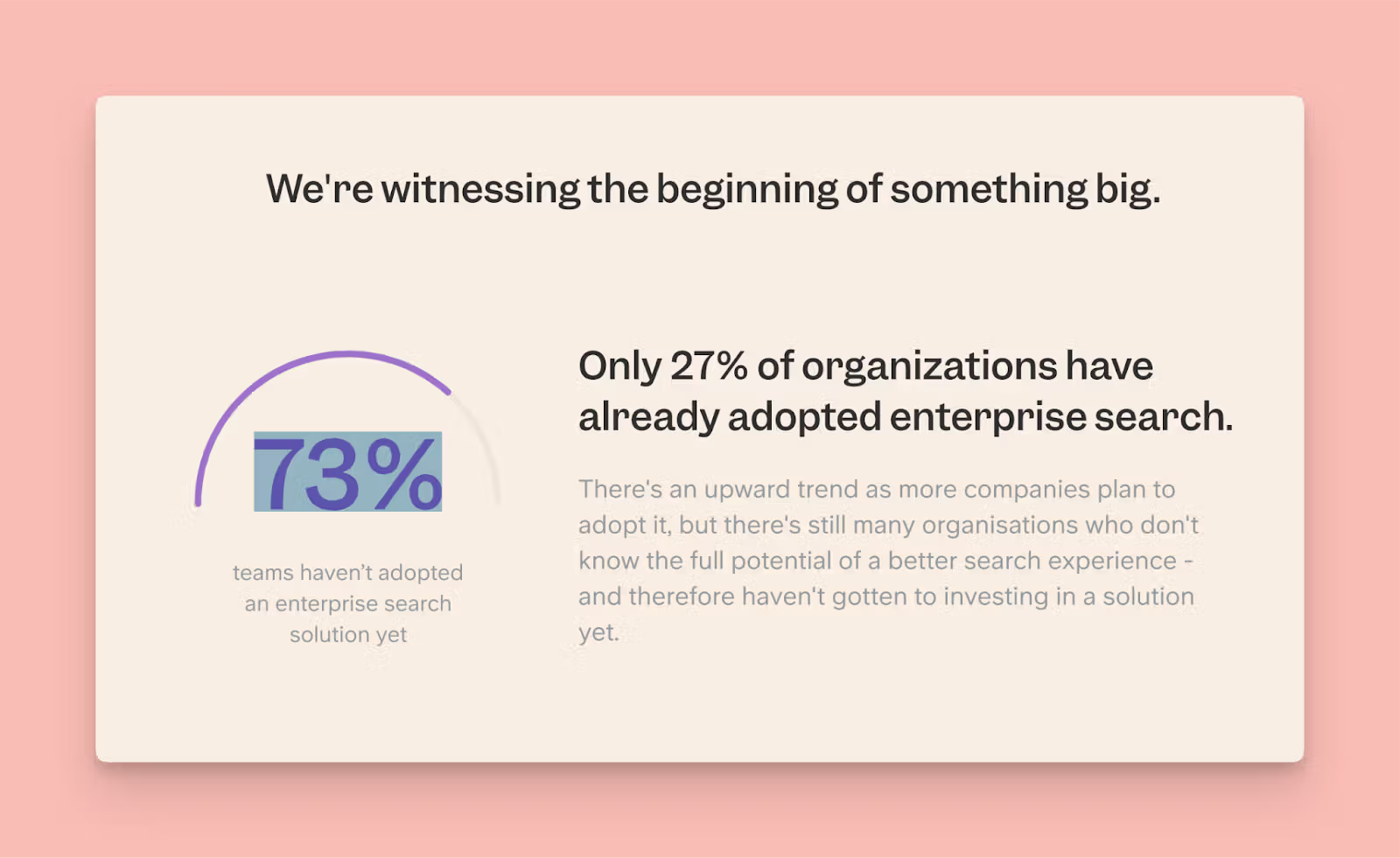
Of the 27% that do use Enterprise Search solutions, they use this:
- 31% use Super by Slite
- 15% use Glean
- 8% use Guru
- The rest are scattered across various solutions
Finding #10: People lose time searching. Everyday.
Think about it: a pricing sheet here, a product spec there...the same documents, the same answers, repeatedly. This repetition adds up.
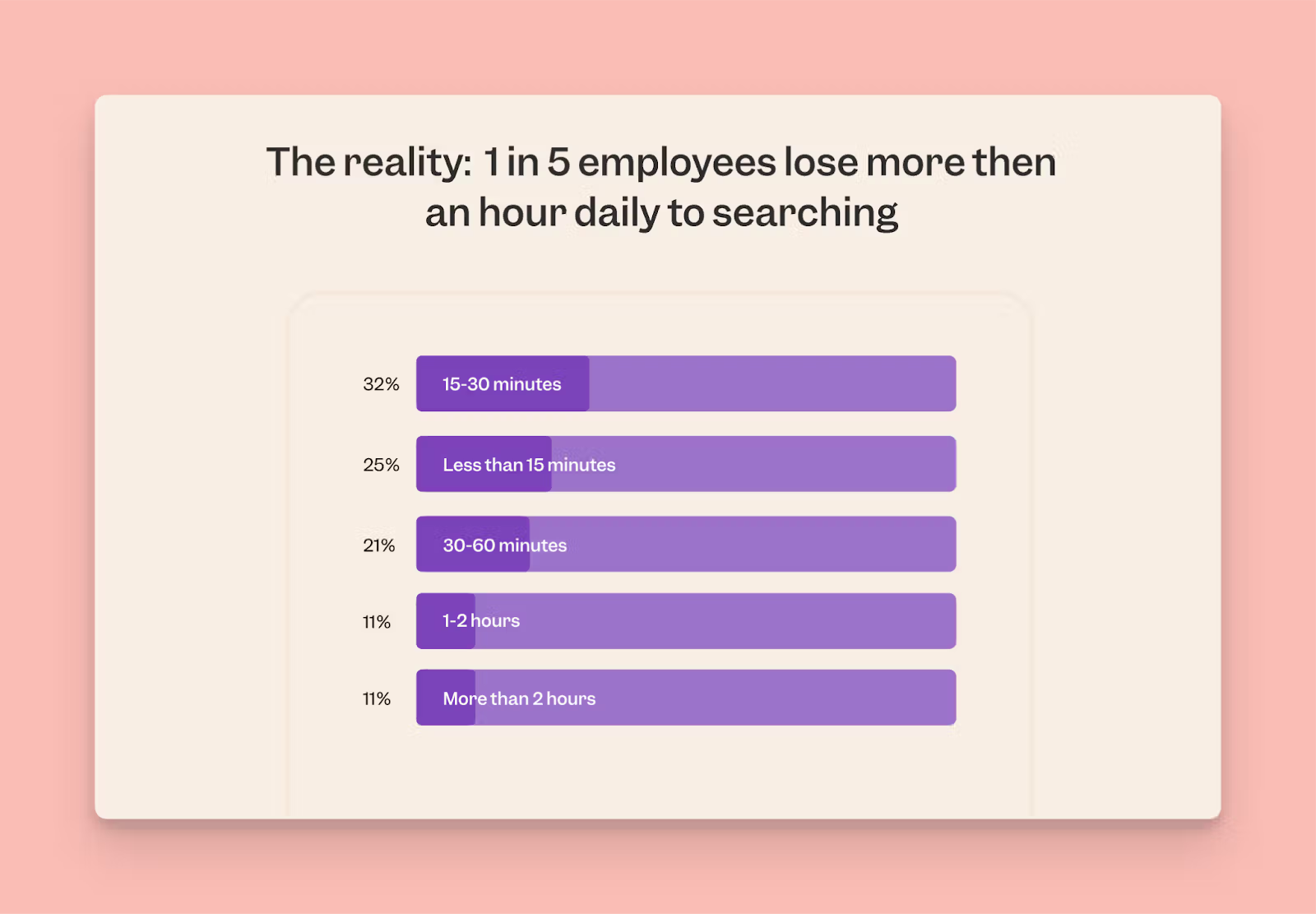
Let's break down the real cost:
Step 1: Weekly Time Waste The average worker spends 3.2 hours each week searching for information.
Step 2: Annual Time Waste (Per Person) There are 52 weeks in a year. So, the yearly wasted time per person is: 3. 2 hours/week * 52 weeks/year = 166.4 hours/year That's over 166 hours per year spent re-finding the same things. To put it another way, assuming a 40 hour work week over a four week month (40 hours/week* 4 weeks/month= 160 hours/month) that's more than a full month of work lost to redundant searching!
Step 3: Team-Wide Impact (Team of 50) Now, consider a team of 50 employees. The total wasted time becomes: 166.4 hours/year/person * 50 people = 8320 hours/year That's a staggering 8,320 hours lost across the team annually.
Step 4: Equivalent Lost Employees To understand the magnitude, let's convert that into full-time employees. A standard work year is 40 hours/week * 52 weeks/year = 2080 hours/year. Therefore, the lost time is equivalent to: 8320 hours / 2080 hours/year/employee = 4 employees In other words, it's like having four full-time employees doing absolutely nothing but searching for things the team already knows.
Most of these searches are for documents that existed, were found before, and somehow slipped back into the digital void. The information was there; it just got lost again.
Summary - It’s sad, really.
When 9 out of 10 first searches fail and 81% of people have to interrupt colleagues for help, we're looking at a broken system.
Organizations are seeing a 45.5% hit to productivity, delays in customer service, and teams creating messy workarounds just to get their jobs done.
That’s exactly why 2025 is important.
We're at the same turning point we saw with cloud storage in 2010 and team chat in 2015. Only 27% of companies have proper search tools, and those that do are seeing dramatic results.
Agorapulse cut their information requests by 90%. Nedap transformed how new employees find information.
Yes, companies need tools that are secure (the top concern for 30% of organizations), work across all platforms, and use AI smartly. But more importantly, they need to realize that in today's distributed workplace, finding information is essential to how teams work.
We've identified five clear warning signs:
- Teams asking the same questions repeatedly
- Shadow documents multiplying across drives
- Constant interruptions for document locations
- Information scattered across tools without a single source of truth
- Employees hoarding files locally out of search anxiety.
The fix requires three clear steps.
First, calculate the true cost - not just time wasted searching, but salary impact and delayed decisions.
Second, invest in knowledge management by building proper information architecture and governance.
Finally, choose search technology that works across platforms and delivers real accuracy.
The current way of working is costing companies both time and trust. It needs to be fixed, even in your org.
If you’re done paying for bad Search…
Look, we all know the drill. You need a quick answer, so you check Slack. Then Drive. Then your knowledge base. Maybe ping a few people. 20 minutes later, you're still piecing together fragments of what should've been a simple answer.
That's why we built Super. It connects Slite, Linear, Slack, Drive, and all your daily tools into one smart system.
Ask real questions like "How's Project X progressing?" or "What's our security compliance status?" and get real answers, not just document links.
SDRs are filling RFPs in minutes instead of hours. Leaders are getting project updates without starting email chains. Teams are finding answers without interrupting colleagues.
Ready to see what it feels like when your tools actually talk to each other? Book a demo with us.

